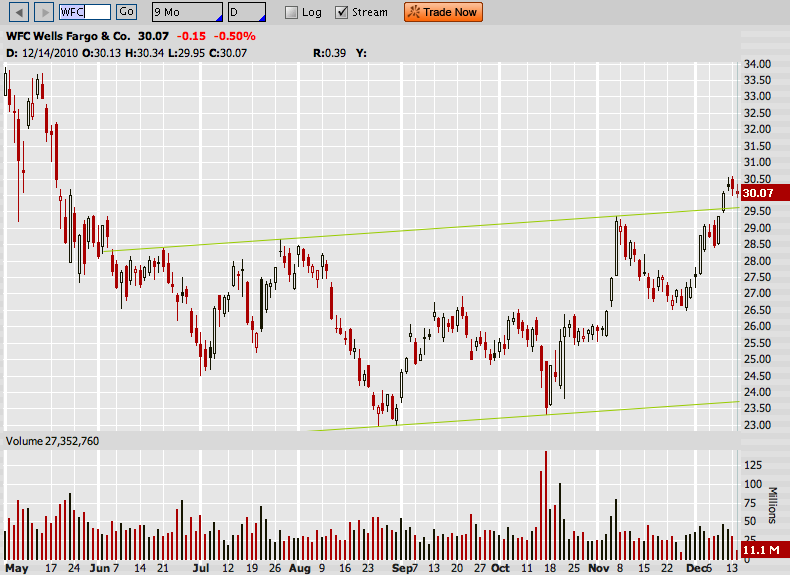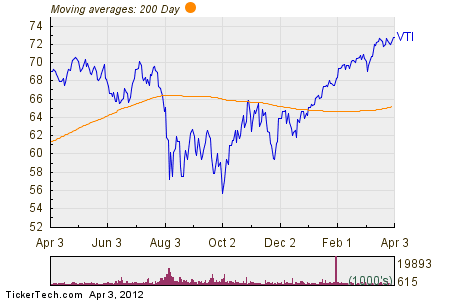Stock Wells Fargo (WFC)
Post on: 15 Июнь, 2015 No Comment

Wells Fargo & Company (NYSE :WFC), is the fourth largest bank holding company in the United States. [1] Wells Fargo & Company is best classified as a diversified financial services company, and with over 80 distinct businesses, Wells Fargo offers a full range of financial products and services and targets all types of clients, from individuals to large corporations in all 50 states as well as the District of Columbia. In 2010, Wells Fargo earned a total of $85 billion in total revenues and a net income of $12.4 billion. [2]
Wells Fargo became the nation’s largest mortgage lender and the second-largest diversified financial services firm in the United States in term of deposits Stock:WFC after acquiring Wachovia (WB). [3] [4] There was a legal dispute with the deal however, as Citigroup had sought to acquire Wachovia as well. Wells Fargo and Citigroup reached a settlement, with Wells Fargo paying Citigroup $100 million to settle the lawsuits. [5] Wells Fargo’s sold $12.6 billion in common stock and $25 billion in preferred stock to the US Government through former U.S. Treasury Secretary Paulson’s $700B Troubled Assets Relief Program (TARP) as part of the deal to raise enough cash for the acquisition. [6] [7] [8]
Contents
Trends and Forces
Wells Fargo has teamed up with Visa (V) to pilot test mobile payments system
Wells Fargo announced that it has teamed up with Visa to pilot test a mobile payments system using smartphones such as the iPhone and Blackberry. The pilot will be conducted by 200 employees of Wells Fargo in San Francisco, where both Visa and Wells Fargo are headquartered. [9] This announcement came shortly after three of the largest telecom carriers (AT&T (T). Verizon Communications (VZ). and T-Mobile announced a joint venture for mobile payments. The upcoming struggle for mobile payments dominance between credit card companies and telecom companies may have huge implications for future earnings as this market begins to develop.
Effects of housing market slowdown
Wells Fargo’s mortgage lending business was hit by slow growth and falling residential real estate prices. The economy as a whole experienced the home equity effect, where homeowners perceive their house values to be lower than they anticipated, and therefore perceive themselves to be relatively less wealthy. As a result, consumers spend and consume less. The number of total housing starts has fallen 63% since peak levels during the end of the housing boom. [10] Wells Fargo Home Mortgages have taken a setback, with higher provisions for credit losses offsetting revenue growth. However, Wells Fargo has been dealing with the mortgage setbacks relatively well due to its wide diversification in product offerings, which allows the company to compensate for poor performance in the home mortgage business.
Subprime bust avoidance
The housing slowdown is often attributed to the collapse of the subprime lending market. Subprime lending. or lending money to customers with poor credit scores (riskier borrowers), can lead to higher loan losses in harsh economic climates or during periods of stagnant or falling housing prices. As customers find themselves unable to make their debt payments, which are higher than average to begin with, defaults rise.

Wells Fargo has fared better than most competitors in the mortgage business, mainly because its mortgages are predominately prime and near-prime. As a result, Wells Fargo has not experienced high rates of default seen in the subprime market. Wells Fargo has avoided much of these losses by deciding not to extend or purchase option adjustable rate mortgages (option ARMs). However, Wachovia Bank, which was acquired by Wells Fargo, took part in Option ARMs and subprime lending.
Potential implementation of Financial Crisis Responsibility Fee
Obama announced a plan to tax the largest banks and financial institutions to recover TARP funds that the government used to bailout many of the banks. The proposed plan calls for a 0.15% tax on each firm’s liabilities. excluding Tier 1 capital and those already insured by the FDIC, with the goal of raising $90 billion over ten years. [11] However, the financial institutions subject to this fee are limited to only those with over $50 billion in assets. If this plan gets passed into law, it could represent a substantial cost to Wells Fargo for up to ten years.
Competition
- Bank of America (BAC) is the world’s leading bank and financial holding company with over $907 billion in deposits and 6,238 offices within the United States. [12]
- JP Morgan Chase (JPM) is one of the world’s largest financial services companies, offering both investment banking as well as commercial banking. It has the third most deposits in the United States with $640 billion. [12]
- Citigroup (C) . another of the commercial banking giants, ranks fourth in the United States in terms of deposits with $321 billion. [12]














